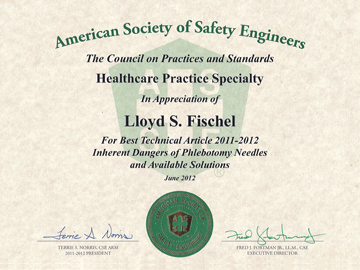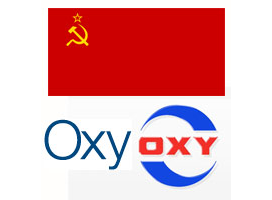 The 36,000-member American Association of Safety Engineers (ASSE) Council of Practices and Standards awarded Lloyd the Best Technical Article (2012) for his research on The Inherent Dangers of Phlebotomy Needles and Available Solutions.
The 36,000-member American Association of Safety Engineers (ASSE) Council of Practices and Standards awarded Lloyd the Best Technical Article (2012) for his research on The Inherent Dangers of Phlebotomy Needles and Available Solutions.
The research paper was published in the ASSE’s HealthBeat publication (V11, #2) whose editing team is headed by Joseph Klancher, Director of Safety, Mayo Clinic.
Read the ASSE Research Paper (PDF)
 In 1999, Gum Tech International contracted with Lloyd’s consulting firm, International Interest Group, to create a joint venture to produce, market, and distribute Zicam, a new approach to treating the common cold. Zicam was heralded as a major health innovation, which has been tested to reduce the duration of the common cold by 71% and has reportedly earned several hundred million dollars for Gum Tech.
In 1999, Gum Tech International contracted with Lloyd’s consulting firm, International Interest Group, to create a joint venture to produce, market, and distribute Zicam, a new approach to treating the common cold. Zicam was heralded as a major health innovation, which has been tested to reduce the duration of the common cold by 71% and has reportedly earned several hundred million dollars for Gum Tech.
 At the peak of the Dot Com era, LLoyd participated in the development of WebMD. During the development of WebMD, Lloyd was hired to produce some of the first live streaming on the Internet in over 200 interviews with scores of bright minds in medicine and the arts. These interviews included U.S. Surgeon General David Satcher, Dr. John Gray (Mars vs. Venus), Dr. Judith Reichman, Dr. Isadore Rosenfeld (Power to the Patient), Thom Hartmann (Last Days of Ancient Sunlight), Jack La Lane, and Time Magazine’s 1999 Doctor of The Year, Brain surgeon Dr. Keith Black. These interviews brought many new ideas and thinking to the forefront—work that presaged TED.
At the peak of the Dot Com era, LLoyd participated in the development of WebMD. During the development of WebMD, Lloyd was hired to produce some of the first live streaming on the Internet in over 200 interviews with scores of bright minds in medicine and the arts. These interviews included U.S. Surgeon General David Satcher, Dr. John Gray (Mars vs. Venus), Dr. Judith Reichman, Dr. Isadore Rosenfeld (Power to the Patient), Thom Hartmann (Last Days of Ancient Sunlight), Jack La Lane, and Time Magazine’s 1999 Doctor of The Year, Brain surgeon Dr. Keith Black. These interviews brought many new ideas and thinking to the forefront—work that presaged TED.
 As Mikhail Gorbachev opened doors to the West for communication, Occidental Petroleum hired Lloyd to produce the first conference where medical scientists from the Soviet Union and the U.S. entered into a live dialogue to discuss research, the first time for such an exchange between the two countries. The Cancer Summit connected doctors at the National Institute of Health in Bethesda, Maryland, and Russian scientists in St. Petersburg. The Cancer Summit was successful in breaking down mental barriers, and was followed by a series of cultural and business exchanges, the latter aimed to commercialize Soviet military technology for peaceful means.
As Mikhail Gorbachev opened doors to the West for communication, Occidental Petroleum hired Lloyd to produce the first conference where medical scientists from the Soviet Union and the U.S. entered into a live dialogue to discuss research, the first time for such an exchange between the two countries. The Cancer Summit connected doctors at the National Institute of Health in Bethesda, Maryland, and Russian scientists in St. Petersburg. The Cancer Summit was successful in breaking down mental barriers, and was followed by a series of cultural and business exchanges, the latter aimed to commercialize Soviet military technology for peaceful means.